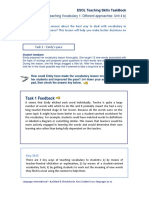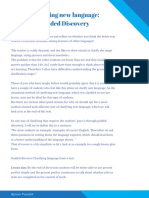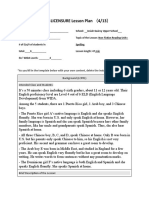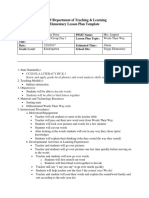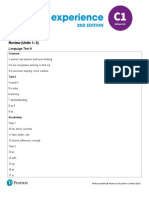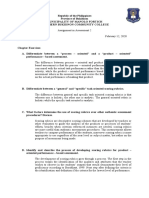Task 1 - To Drill, or Not To Drill?
Task 1 - To Drill, or Not To Drill?
Uploaded by
ThisIsBumpfCopyright:
Available Formats
Task 1 - To Drill, or Not To Drill?
Task 1 - To Drill, or Not To Drill?
Uploaded by
ThisIsBumpfOriginal Description:
Original Title
Copyright
Available Formats
Share this document
Did you find this document useful?
Is this content inappropriate?
Copyright:
Available Formats
Task 1 - To Drill, or Not To Drill?
Task 1 - To Drill, or Not To Drill?
Uploaded by
ThisIsBumpfCopyright:
Available Formats
ESOL Teaching Skills TaskBook
Drilling techniques: Unit 2 e)
LanguagesInternationalAuckland&Christchurch,NewZealandwww.languages.ac.nz
Do you often avoid drilling new language items with your students? Is this
becauseyoudontthinkitsusefulorisitbecauseyouarenotsurehowtogo
about it? This lesson aims to get you thinking about the role of drilling in
languagefocusedlessonsanddemonstratehowtogoaboutit.
Two teachers are discussing drilling in the staffroom.
Mona: Then after Ive done feedback on the matching tasks, I thought Id drill the words.
Louise: Really?
Mona: Yeah why not?
Louise: I never drill language its so old-fashioned.
Mona: Do you think so? I was taught to drill on my training course and that was only last
year.
Louise: Ive been teaching for just over ten years now and Ive never drilled anything.
Mona: Interesting. What do your students say?
Louise: Nothing.
Mona: Mine never complain when I drill them.
Whose opinion do you agree with? Jot down your ideas / suggestions
on a note pad, then check the answer key below.
Task1Todrill,ornottodrill?
Task1Feedback
Drilling is a teaching skill that can sometimes be considered controversial.
Teachers who dont like it see it as a relic of the audiolingual approach to
language teaching. Other teachers think that drilling is useful because that is
howtheyliketolearnalanguage.Thereisanothergroupofteacherswhoavoid
drillingbecausetheyarenotsureofhowtodrill.Thislessonwillworkthrough
some of those issues associated with the skill and describe different drilling
procedures.
ESOL Teaching Skills TaskBook
Drilling techniques: Unit 2 e)
LanguagesInternationalAuckland&Christchurch,NewZealandwww.languages.ac.nz
Below are some opinions about drilling. Sort them into two groups,
opinions for drilling and those against.
NB. Two of the opinions are probably NOT true. Can you decide which two
they are?
1. Many students expect their teachers to drill new language.
2. Part of language learning is a physical skill. Drilling is like sending students speech
organs to the gym.
3. Drilling doesnt involve real communication.
4. Drilling helps students to memorise new language.
5. Drilling can help students with pronunciation. It allows them to feel new sounds.
6. Drilling means that the teacher imposes new language on students and is unnatural.
7. Even if teachers dont drill, students will often quietly drill themselves because the want
to have a go at saying new language items.
8. Drilling wont necessarily lead to internalisation and acquisition of new language.
9. Drilling helps students to understand new language.
for against
Task2Whataresomeoftheissues?
KeySkill
Whatisdrilling?Initsmostbasicformdrillinginvolvesteachersaskingstudents
to repeat individual words or utterances. The teacher gives a model of the
languageandthestudentsrepeatiteitherinunisonorindividuallyorboth.
ESOL Teaching Skills TaskBook
Drilling techniques: Unit 2 e)
LanguagesInternationalAuckland&Christchurch,NewZealandwww.languages.ac.nz
Check your ideas in the answer key.
Match the five ways of drilling 1 to 5 with the definitions a to e and the
examples i to v.
Ways of drilling Definitions Examples
1. choral
2. individual
3. open pair
4. substitution
5. transformation
Task3Waysofdrilling
KeySkill
Drillingprobablydoesnotaidtheacquisitionorlearningofnewlanguageitems,
but it can help students with the pronunciation of language. It may not be a
natural and highly communicative classroom activity, but students seem to
want to be drilled nonetheless. It helps if students understand the language
that teachers drill. In other words, the meaning should be clarified first
otherwisedrillingsimplyinvolvesmindlessrepetition.
Definitions
a. Students repeat an utterance. The teacher says or holds up a new word or phrase.
Students repeat the first utterance, but replace a word or phrase from that utterance
with the new word or phrase.
b. The teacher drills one student in a question and a second student in an answer to
that question. The two students then repeat their question and answer exchange
with the rest of the class listening.
c. The teacher says a word or an utterance and the whole class repeats that word or
utterance together in unison.
d. The teacher says an utterance and the students say something similar to the
teachers utterance, but, in doing so, they change a key structure.
e. The teacher says a word or utterance and then nominates a student to say that word
or utterance.
ESOL Teaching Skills TaskBook
Drilling techniques: Unit 2 e)
LanguagesInternationalAuckland&Christchurch,NewZealandwww.languages.ac.nz
Check your ideas in the answer key.
KeySkill
Drilling does not have to always be repetitive and uncreative. Substitution and
transformationdrillscanprovidestudentswithasmalldegreeofcreativityand
cognitiveeffort.
Examples
i. Teacher: Hes just gone home. - J in Yong.
Student: Hes just got home.
ii. Teacher: Hes just gone home
Students: Hed just gone home.
iii. Teacher: Wheres he gone? - Yang.
Student: Wheres he gone?
Teacher: Hes just gone home. - Sven.
Student: Hes just gone home.
Teacher: OK again. Question Yang. Answer Sven.
iv. Teacher: Hes just gone home. - Everyone.
Students: Hes just gone home.
v. Students: Hes just gone home.
Teacher: the bank.
Students: Hes just gone to the bank.
ESOL Teaching Skills TaskBook
Drilling techniques: Unit 2 e)
LanguagesInternationalAuckland&Christchurch,NewZealandwww.languages.ac.nz
Numbers 1 to 8 below are eight steps in the process of drilling a new
word or utterance. Put these steps in the correct order. Letters a to h give
a rational for each step. Once you have ordered the steps, match a
rationale to each step.
Eight steps of drilling Rationale
1. Once students give you the word or utterance, provide your own oral
model at a natural speed
2. Students repeat the language together as a group
3. Having broken down the oral model of the language, repeat it again
at a more natural speed
4. If the word or utterance you want to drill is on the white board, start
by wiping it off
5. Re-elicit the language you want to drill using the prompts
6. Nominate individual students and get them to repeat the word or
utterance
7. Show students a prompt a picture or some key words that relate to
the language you want to drill
8. Highlight any key pronunciation features of the new language
demonstrate these orally rather than using the white board
Task4Fivestepstodrilling
Rationale for each step
a. so that students have some visual representation of the language you want to drill.
b. so that you can check the pronunciation of the new language by individual students.
c. so that the first oral model that students hear is a natural one.
d. so that students have to think a little bit about the language they are going to repeat.
e. so that students focus on pronunciation features such as stress, weak forms and linking.
f. so that all students have the opportunity to say the new language without being
heard by the rest of the class.
g. so that students dont just read the new language aloud and they have to listen
carefully in order to repeat.
h. so that students will repeat the language with a more natural rhythm.
ESOL Teaching Skills TaskBook
Drilling techniques: Unit 2 e)
LanguagesInternationalAuckland&Christchurch,NewZealandwww.languages.ac.nz
Check your ideas in the answer key.
ESOL Teaching Skills TaskBook
Drilling techniques: Unit 2 e)
LanguagesInternationalAuckland&Christchurch,NewZealandwww.languages.ac.nz
Thinkingaboutyourteaching
Findacolleaguewhospeaksasecondlanguagethatyoudontknowatall.Askyour
colleaguetogiveyoutwoorthreeminilessonsinthatlanguageandspecificallyask
that person to drill you in the new language. After the lesson write down your
reactionstobeingdrilledandthinkaboutwhyyouhadthosereactions.
NoteyourreactionsandthoughtsinyourTeachinglog.
Takingittotheclassroom
If you dont normally drill your students, try doing it over a period of about four or
five lessons. If you normally drill, trying not doing it over the same period of time.
After that, give your students a questionnaire about drilling did they like it or did
theymissit?Why?
Wanttofindoutmore?
Onpages255260ofLearningTeaching(2
nd
edition)byJimScrivener(Macmillan
2005),thereisfurtherreadingondrilling.
Forsomepracticalideasondrillingoptionsseepages2067ofThePracticeofEnglish
LanguageTeaching(4
th
edition)byJeremyHarmer(Pearson2007).
RelatedTaskBooklessons...
YoumaybeinterestedinthefollowinglessonsintheESOLTeachingSkillsTaskBook
series,relatingtothistopic:
Unit2g)Correctingspokenerrors:dealswitherrorcorrectionofstudentsspoken
errorsintheclassroom.
ESOL Teaching Skills TaskBook
Drilling techniques: Unit 2 e)
LanguagesInternationalAuckland&Christchurch,NewZealandwww.languages.ac.nz
Task2Feedback
for against
1. Many students expect their teachers to
drill new language.
2. Part of language learning is a physical
skill. Drilling is like sending students
speech organs to the gym.
5. Drilling can help students with
pronunciation. It allows them to feel new
sounds.
7. Even if teachers dont drill, students
will often quietly drill themselves because
the want to have a go at saying new
language items.
3. Drilling doesnt involve real
communication.
6. Drilling means that the teacher imposes
new language on students and is unnatural.
8. Drilling wont necessarily lead to
internalisation and acquisition of new
language.
Probably not true: 4. Drilling helps students to memorise new language.
Probably not true: 9. Drilling helps students to understand new language.
Task3Feedback
1. choral c and iv
2. individual e and i
3. open pair b and iii
4. substitution a and v
5. transformation d and ii
Task4Feedback
4. g
7. a
5. d
1. c
8. e
3. h
2. f
6. b.
This work is published under the Creative Commons 3.0 New Zealand Attribution Non-commercial Share Alike
Licence (BY-NC-SA). Under this licence you are free to copy, distribute, display and perform the work as well as
to remix, tweak, and build upon this work noncommercially, as long as you credit the author/s and license your
new creations under the identical terms.
AnswerKey
You might also like
- Ell Student Observation ChecklistDocument4 pagesEll Student Observation Checklistapi-369966486No ratings yet
- Grade 3 e Phonics Lesson Plan LaDocument6 pagesGrade 3 e Phonics Lesson Plan Laapi-264279988100% (1)
- Lesson Plan 11 4 Dar ConsejosDocument6 pagesLesson Plan 11 4 Dar Consejosapi-314623879No ratings yet
- Teaching English to Speakers of Other LanguagesFrom EverandTeaching English to Speakers of Other LanguagesRating: 3 out of 5 stars3/5 (1)
- The Audiolingual MethodDocument6 pagesThe Audiolingual MethodBalvinder0% (1)
- Mini Lesson Plan 1Document3 pagesMini Lesson Plan 1api-260889954No ratings yet
- The Silent WayDocument31 pagesThe Silent WayHnin HninNo ratings yet
- n2457 Esol Teaching Skills Taskbook Unit 4 B Teaching Vocabulary 1 Different ApproachesDocument6 pagesn2457 Esol Teaching Skills Taskbook Unit 4 B Teaching Vocabulary 1 Different ApproachesVesna PopovicNo ratings yet
- 1 Clarifying New Language Situational Language ClarificationDocument6 pages1 Clarifying New Language Situational Language ClarificationRenanNo ratings yet
- Clarifying New Language: Guided DiscoveryDocument4 pagesClarifying New Language: Guided DiscoveryRenanNo ratings yet
- 03 Vocabular y SpeakingDocument35 pages03 Vocabular y SpeakingEric MozombiteNo ratings yet
- Nhóm 3 - SPA C K11 - OUTLINE - Audio Lingual MethodDocument5 pagesNhóm 3 - SPA C K11 - OUTLINE - Audio Lingual Methodkhanhdoan27072003No ratings yet
- Unit 16,17Document8 pagesUnit 16,17Zeynab AhmadzadaNo ratings yet
- Lesson Plan Form - LBS 400: Candidate: Janet Ponce Subject: Language Arts Grade Level(s) : DateDocument8 pagesLesson Plan Form - LBS 400: Candidate: Janet Ponce Subject: Language Arts Grade Level(s) : Dateapi-377118130No ratings yet
- Anh 7 global success ky 1Document145 pagesAnh 7 global success ky 1Bảo KimNo ratings yet
- Yanxi Esl Lesson Plan 4 13Document6 pagesYanxi Esl Lesson Plan 4 13api-665437062No ratings yet
- Teaching Guide 1 1 2Document36 pagesTeaching Guide 1 1 2BasitKhanNo ratings yet
- Task 1 - What's The Real Meaning?Document6 pagesTask 1 - What's The Real Meaning?gogolee2013No ratings yet
- Background of Audio-Lingual MethodDocument4 pagesBackground of Audio-Lingual Methodindra tamaraNo ratings yet
- The Master 140 Hour TEFL Course: TKT Unit 5 Section 1: Classroom Language - Teacher and Student LanguageDocument7 pagesThe Master 140 Hour TEFL Course: TKT Unit 5 Section 1: Classroom Language - Teacher and Student LanguageSuzana AnđelkovićNo ratings yet
- Giáo án tiếng anh 7 Global ( bản khác sách mềm ) học kì 1Document124 pagesGiáo án tiếng anh 7 Global ( bản khác sách mềm ) học kì 1puyen241004No ratings yet
- Instructions For Using Textbooks, Studying Materials: Week: 1 Period 1Document106 pagesInstructions For Using Textbooks, Studying Materials: Week: 1 Period 1Jan LeNo ratings yet
- Yanxi Esl Lesson Plan 3 16Document9 pagesYanxi Esl Lesson Plan 3 16api-665437062No ratings yet
- Methods_mergedDocument12 pagesMethods_mergedMoitrei BharadwajNo ratings yet
- Lesson Plan 7Document104 pagesLesson Plan 7Myyne 30No ratings yet
- KEY To FINAL TEST - Teaching MethodologyDocument4 pagesKEY To FINAL TEST - Teaching Methodologynguyen anNo ratings yet
- BBC 1Document108 pagesBBC 1Adriana AssunçãoNo ratings yet
- How To Teach GrammarDocument40 pagesHow To Teach GrammarQuang Hien Vo100% (1)
- Session #2 and #3 - Online TTCDocument6 pagesSession #2 and #3 - Online TTCelnazzarei1994No ratings yet
- 1Document60 pages1MajddiNo ratings yet
- Gata 7 Global - HkiDocument123 pagesGata 7 Global - HkiHương HàNo ratings yet
- Concept Check QuestionsDocument9 pagesConcept Check QuestionsAhmad JanNo ratings yet
- Alternative Approaches and MethodsDocument21 pagesAlternative Approaches and Methodsdhianingwahyu sugiartoNo ratings yet
- Nafrianti 1212817023 (TEFL Observation)Document5 pagesNafrianti 1212817023 (TEFL Observation)cassha04No ratings yet
- MAKALAH EYL KEL. 7 fiksDocument12 pagesMAKALAH EYL KEL. 7 fiksFajrina Zulfa DarumiarsiNo ratings yet
- 41 Practical Work 1Document13 pages41 Practical Work 1мирослава ТурукNo ratings yet
- UNLV/Department of Teaching & Learning Elementary Lesson Plan TemplateDocument2 pagesUNLV/Department of Teaching & Learning Elementary Lesson Plan Templateapi-403209118No ratings yet
- Checklist of Instructional Modifications For LEP StudentsDocument5 pagesChecklist of Instructional Modifications For LEP Studentsapi-278468211No ratings yet
- Gata 7 Global - HkiDocument127 pagesGata 7 Global - HkimaangiangdhNo ratings yet
- Greetings Lesson PlanDocument6 pagesGreetings Lesson PlanNella Ruiz100% (4)
- Application of Basic Ways of Studying Vocabulary On English LessonsDocument10 pagesApplication of Basic Ways of Studying Vocabulary On English Lessonsnurlibek ilyasovNo ratings yet
- ALM FixsDocument2 pagesALM FixsFitria Mardi PratiwiNo ratings yet
- Pedagogy Comprehensive Assignment 1Document9 pagesPedagogy Comprehensive Assignment 1favour.b247No ratings yet
- Metodika MuhazireDocument8 pagesMetodika Muhazired5gz52p5bdNo ratings yet
- Presentation Techniques TKT Module 1Document4 pagesPresentation Techniques TKT Module 1seduction123No ratings yet
- ESP 2 Final Term Exam (Valdo Varelleo Zulla 1619500066)Document12 pagesESP 2 Final Term Exam (Valdo Varelleo Zulla 1619500066)Takasu ryuujiNo ratings yet
- Slang Lesson PlanDocument4 pagesSlang Lesson PlanPaola CorsiNo ratings yet
- Lesson 1 Long VowelsDocument3 pagesLesson 1 Long Vowelsapi-271846116No ratings yet
- Lesson Plan How To Learn Grammar and VocabularyDocument12 pagesLesson Plan How To Learn Grammar and Vocabularyruchka KalamNo ratings yet
- Final Assessment On ICTFLDocument5 pagesFinal Assessment On ICTFLOzoda TuxliyevaNo ratings yet
- Baseline - Lesson PlanDocument5 pagesBaseline - Lesson Planapi-552123495No ratings yet
- TKT Unit 5Document31 pagesTKT Unit 5Jelena Mitrovic100% (1)
- Teaching Notes 2 PDFDocument44 pagesTeaching Notes 2 PDFNaw0% (1)
- Demo ClassDocument2 pagesDemo Classletranminhthu09112006No ratings yet
- TEYL Intensive Self-Study Course by CoH Shared VersionDocument105 pagesTEYL Intensive Self-Study Course by CoH Shared VersionHan Lin Lin HtetNo ratings yet
- GESE G3 - Classroom Activity 4 (Adult Learners) - Asking Simple Questions About Everyday LifeDocument5 pagesGESE G3 - Classroom Activity 4 (Adult Learners) - Asking Simple Questions About Everyday LifeclaudiaNo ratings yet
- Question 10 NewDocument5 pagesQuestion 10 NewDaniel ShebiruNo ratings yet
- Lesson PlanDocument5 pagesLesson PlanErnest SlachNo ratings yet
- ESOLNational 4 Everyday Life 1 Teacher NotesDocument111 pagesESOLNational 4 Everyday Life 1 Teacher NotesvoovnsNo ratings yet
- Anh 8 - Unit 123+review 1Document122 pagesAnh 8 - Unit 123+review 1Thư LýNo ratings yet
- Answer Key Review (Units 1-3) : Language Test ADocument12 pagesAnswer Key Review (Units 1-3) : Language Test ALuanneNo ratings yet
- Grade 3 WHLPDocument32 pagesGrade 3 WHLPNica Joy HernandezNo ratings yet
- AFRICAN Language SituationDocument8 pagesAFRICAN Language SituationBrad100% (1)
- PrimaryKeyEE119Document3 pagesPrimaryKeyEE119Anto PriscoNo ratings yet
- Maths Assessment Year 3 Term 3: Number and Place Value: NameDocument4 pagesMaths Assessment Year 3 Term 3: Number and Place Value: NamebayaNo ratings yet
- Assignment 1Document5 pagesAssignment 1Noelli Mae Bacol91% (23)
- Let Reviewer March 2018Document61 pagesLet Reviewer March 2018Kevin Lee100% (1)
- Teacher Centered VS Students CenteredDocument10 pagesTeacher Centered VS Students CenteredRaniena Chokyuhyun100% (1)
- Unit 5 Skills Work NewDocument2 pagesUnit 5 Skills Work Newmohamedimo882No ratings yet
- Introduction To The Semantic Web: Payam BarnaghiDocument62 pagesIntroduction To The Semantic Web: Payam BarnaghiGlenn OsabalNo ratings yet
- Grade 6 English Language Model ExaminationDocument8 pagesGrade 6 English Language Model Examinationdaalee199780% (5)
- Plan Platforma: SCARA 1:50Document1 pagePlan Platforma: SCARA 1:50Roman BentaloNo ratings yet
- Preface To Lyrical BalladsDocument14 pagesPreface To Lyrical BalladsKleyton PereiraNo ratings yet
- The English Phrasal VerbDocument6 pagesThe English Phrasal VerbRhypyon DemplonNo ratings yet
- Public Speaking AssignmentDocument4 pagesPublic Speaking AssignmentAmanda CopelandNo ratings yet
- IB English Language and Literature Paper 1 Topsheet March 2023Document2 pagesIB English Language and Literature Paper 1 Topsheet March 2023Rebecca Ward0% (2)
- Python Assignment 2Document3 pagesPython Assignment 2study materialNo ratings yet
- Aou Prog Skills 1 TB PrelimsDocument19 pagesAou Prog Skills 1 TB PrelimsYousif AliNo ratings yet
- Kami Export - Adriá Cerdán Agrasar - Can 3Document2 pagesKami Export - Adriá Cerdán Agrasar - Can 3familiatorresperalesNo ratings yet
- Future Plans-GUIDEDocument11 pagesFuture Plans-GUIDEjuanfelipe amu s.No ratings yet
- Hebrewpod 101Document15 pagesHebrewpod 101Dasalodel77No ratings yet
- Common Phrasal VerbsDocument7 pagesCommon Phrasal VerbsChinnaBabuNo ratings yet
- Buka e Kgolo 5 Sesotho - 2Document36 pagesBuka e Kgolo 5 Sesotho - 2lesedilesedi179No ratings yet
- BAB 1 Basing Kelas XIIDocument15 pagesBAB 1 Basing Kelas XIIDelia Nurul AqilaNo ratings yet
- Rabelais 'Carnival in Kerala Through The Eyes of BakhtinDocument5 pagesRabelais 'Carnival in Kerala Through The Eyes of BakhtinJibin Joseph SebastianNo ratings yet
- ENG-216-READING LEVEL 3-Lesson 1Document23 pagesENG-216-READING LEVEL 3-Lesson 1Đức TrọngNo ratings yet
- Podcast Script Writing Guide: Additional Help Scripting Your PodcastDocument2 pagesPodcast Script Writing Guide: Additional Help Scripting Your PodcastCaila AlfonsoNo ratings yet
- Chap6. Course Planning & Syllabus DesignDocument44 pagesChap6. Course Planning & Syllabus DesignMifta hatur rizkyNo ratings yet
- Proposal Skripsi Bahasa InggrisDocument21 pagesProposal Skripsi Bahasa InggrisKiki Andila100% (1)
- SDL Lesson Plan (Guided Reading)Document3 pagesSDL Lesson Plan (Guided Reading)PamelaNo ratings yet







